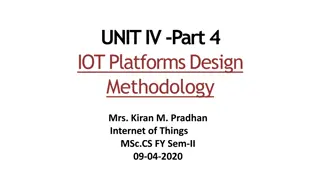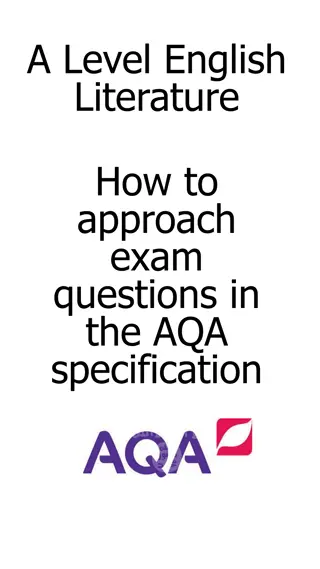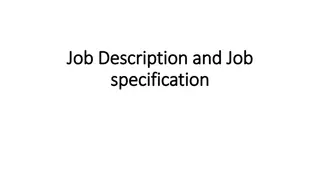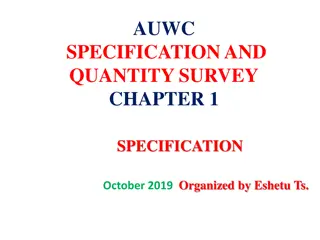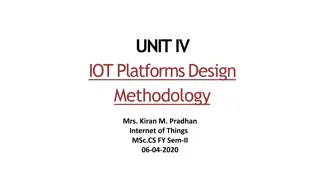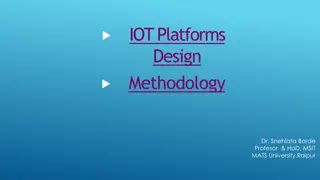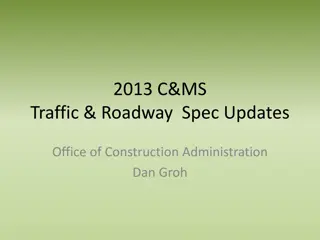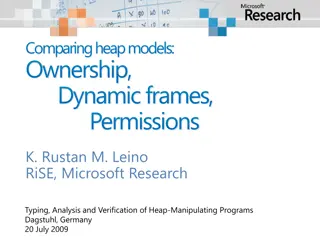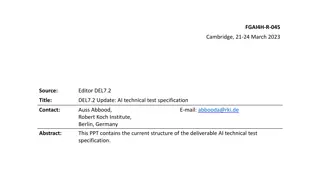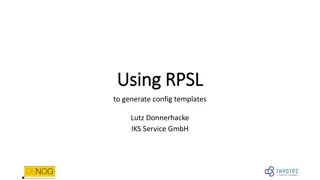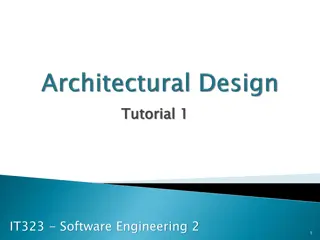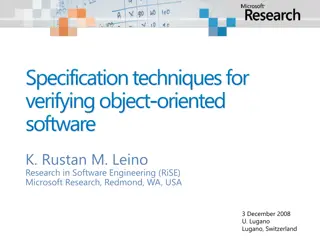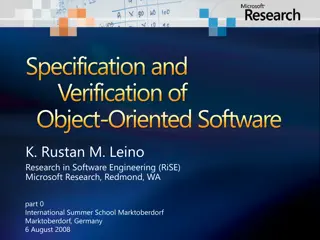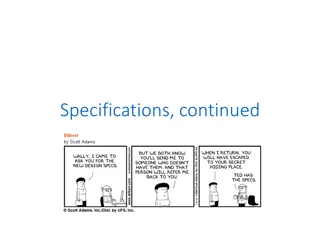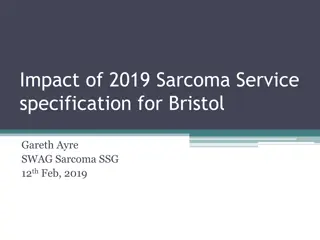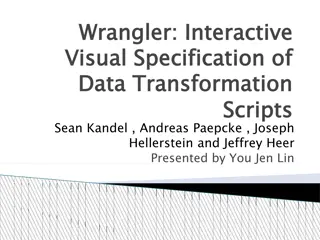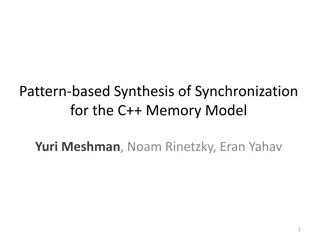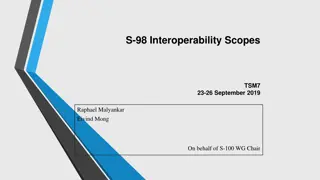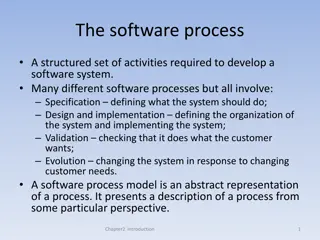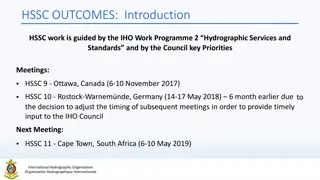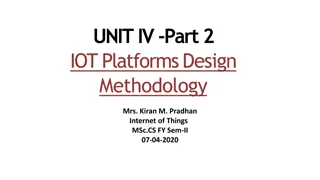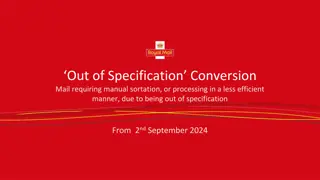Engaging Students' Voices in Curriculum Making
Understanding the importance of student views in the curriculum-making process and the need for an authentic experience to empower student voice. The Independent Investigation explores findings from student surveys and A-level specification preferences. Delve into how investigations were organized a
1 views • 22 slides
Building a Macrostructural Standalone Model for North Macedonia: Model Overview and Features
This project focuses on building a macrostructural standalone model for the economy of North Macedonia. The model layout includes a system overview, theory, functional forms, and features of the MFMSA_MKD. It covers various aspects such as the National Income Account, Fiscal Account, External Accoun
2 views • 23 slides
NAMI Family Support Group Model Overview
This content provides an insightful introduction to the NAMI family support group model, emphasizing the importance of having a structured model to guide facilitators and participants in achieving successful support group interactions. It highlights the need for a model to prevent negative group dyn
6 views • 23 slides
Software Requirement Analysis and Documentation Process
The requirement analysis and specification process involves gathering information from customers, identifying the problem, solutions, data requirements, complexities, and potential interfaces. Key components of a Software Requirements Specification (SRS) document include functional requirements, non
0 views • 23 slides
Design Methodology for IoT Platforms: Functional View Specification
Functional view specification in IoT platform design methodology involves defining functional groups for devices, communication, services, management, security, and applications. Each group serves specific purposes such as device monitoring, communication protocols, service provision, system managem
1 views • 12 slides
Understanding Entity-Relationship Model in Database Systems
This article explores the Entity-Relationship (ER) model in database systems, covering topics like database design, ER model components, entities, attributes, key attributes, composite attributes, and multivalued attributes. The ER model provides a high-level data model to define data elements and r
0 views • 25 slides
Communication Models Overview
The Shannon-Weaver Model is based on the functioning of radio and telephone, with key parts being sender, channel, and receiver. It involves steps like information source, transmitter, channel, receiver, and destination. The model faces technical, semantic, and effectiveness problems. The Linear Mod
0 views • 8 slides
Approaching Exam Questions in A Level English Literature: AQA Specification Overview
Explore how to approach exam questions in A Level English Literature following the AQA specification, focusing on question types such as Aspects of Tragedy and Social and Political Protest Writing. The guidance includes insights on interpreting Shakespeare extracts, understanding tragic trajectory,
0 views • 28 slides
Understanding Atomic Structure: Electrons, Energy Levels, and Historical Models
The atomic model describes how electrons occupy energy levels or shells in an atom. These energy levels have specific capacities for electrons. The electronic structure of an atom is represented by numbers indicating electron distribution. Over time, scientists have developed atomic models based on
0 views • 5 slides
Importance of Job Description and Job Specification in Job Analysis
Job description and job specification are essential components of job analysis, providing crucial data for HR managers to understand job requirements and find the right candidate. While not legal requirements, they play a vital role in recruiting, selecting, and placing employees effectively. Job de
0 views • 6 slides
Understanding ROC Curves and Operating Points in Model Evaluation
In this informative content, Geoff Hulten discusses the significance of ROC curves and operating points in model evaluation. It emphasizes the importance of choosing the right model based on the costs of mistakes like in disease screening and spam filtering. The content explains how logistical regre
7 views • 11 slides
Understanding Specification and Quantity Survey in Construction Projects
Specification in construction projects is a detailed written description of materials, workmanship, and instructions for executing tasks. Specifications complement drawings and serve as contract documents, guiding contractors on materials, methods, standards, and project requirements.
0 views • 31 slides
IoT Platforms Design Methodology for Efficient System Development
Designing IoT systems can be complex due to the interactions between various components like devices, network resources, web services, analytics, applications, and servers. This article presents a generic design methodology for IoT systems that is independent of specific products or services, leadin
2 views • 8 slides
Eduqas GCSE Geography Specification Overview
Welcome to the online meeting of the Eduqas regional team! This session provides information on the GCSE Geography Specification, including changes for 2021. The ethos of the qualification emphasizes developing learners' geographer thinking skills. The course is divided into three components coverin
0 views • 33 slides
IoT Platforms Design Methodology by Dr. Snehlata Barde - Overview
Designing IoT systems can be complex, but with a generic methodology like the one proposed by Dr. Snehlata Barde, designing, testing, and maintaining IoT systems becomes more efficient. The methodology focuses on purpose, requirements, process specification, domain model specification, information m
0 views • 9 slides
Understanding the OSI Model and Layered Tasks in Networking
The content highlights the OSI model and layered tasks in networking, explaining the functions of each layer in the OSI model such as Physical Layer, Data Link Layer, Network Layer, Transport Layer, Session Layer, Presentation Layer, and Application Layer. It also discusses the interaction between l
1 views • 41 slides
Regression Diagnostics for Model Evaluation
Regression diagnostics involve analyzing outlying observations, standardized residuals, model errors, and identifying influential cases to assess the quality of a regression model. This process helps in understanding the accuracy of the model predictions and identifying potential issues that may aff
1 views • 12 slides
2013 C&MS Traffic and Roadway Specification Updates Overview
Detailed overview of key specification updates in 2013 for traffic, roadway, guardrail, fence, maintaining traffic, and concrete barriers. Includes changes in materials, methods of measurement, and new items like fenceline seeding and mulching. Contractor requirements and measurement specifics are h
0 views • 29 slides
MFMSA_BIH Model Build Process Overview
This detailed process outlines the steps involved in preparing, building, and debugging a back-end programming model known as MFMSA_BIH. It covers activities such as data preparation, model building, equation estimation, assumption making, model compilation, and front-end adjustment. The iterative p
0 views • 10 slides
A Comparative Analysis of Heap Specification Approaches
This presentation discusses various approaches to heap specification, including ownership systems, dynamic frames, permissions, and capabilities. It explores challenges related to invariants and frames, showcasing examples from RockBand and Object state specifications. The discussion covers tools li
0 views • 11 slides
Proposal for Radio Controlled Model Aircraft Site Development
To establish a working relationship for the development of a site suitable for radio-controlled model aircraft use, the proposal suggests local land ownership with oversight from a responsible agency. Collins Model Aviators is proposed as the host club, offering site owner liability insurance throug
0 views • 20 slides
UBU Performance Oversight Engagement Framework Overview
Providing an overview of the UBU Logic Model within the UBU Performance Oversight Engagement Framework, this session covers topics such as what a logic model is, best practice principles, getting started, components of the logic model, evidence & monitoring components, and next steps. The framework
0 views • 33 slides
Regression Model for Predicting Crew Size of Cruise Ships
A regression model was built to predict the number of crew members on cruise ships using potential predictor variables such as Age, Tonnage, Passenger Density, Cabins, and Length. The model showed high correlations among predictors, with Passengers and Cabins being particularly problematic. The full
0 views • 16 slides
Comprehensive Overview of AI Technical Test Specification
This presentation provides a detailed look at the AI technical test specification authored by Auss Abbood from the Robert Koch Institute in Berlin. It covers best practices in AI testing, essential tests for assessment platforms, testing principles, test levels, test types, and more. The deliverable
0 views • 15 slides
Advanced Routing Policy Specification Language (RPSL) Concepts and Examples
Explore advanced concepts in Routing Policy Specification Language (RPSL) including peering policies, route-map actions, and community-based prepending. Learn how to automate processing and update peering policies directly from RADB for efficient network management.
0 views • 11 slides
Introduction to OpenMP: A Parallel Programming API
OpenMP, an API for multi-threaded, shared memory parallelism, is supported by compilers like C/C++ and Fortran. It consists of compiler directives, runtime library resources, and environment variables. The history spans various specification versions, with features like tasks, SIMD, and memory model
0 views • 33 slides
Designing System Architecture Before Requirements: Importance and Best Practices
When describing a system, designing the architecture before completing the requirements specification can aid in structuring the specification, enabling the development of subsystem specifications concurrently, facilitating hardware manufacture by subcontractors, and providing a model for system cos
0 views • 21 slides
Specification Techniques for Verifying Object-Oriented Software
This research discusses specification techniques for verifying object-oriented software, emphasizing the importance of building and maintaining correct programs. It delves into the Verified Software Initiative's vision for reliable computer programs and introduces Spec# programming system, demo, and
0 views • 24 slides
Latest Developments in S-124 Product Specification
The S-124 product specification development includes updating data models, datasets, and distribution processes. Key tasks such as NAVWARN types general and detailed work have been completed with submissions to GI Registry. Approval delays due to system glitches are noted, impacting the soft list an
0 views • 8 slides
Object-Oriented Software: Specification and Verification
This resource delves into theory, techniques, and architectures for verifying object-oriented software, focusing on a basic program verifier for dynamically allocated objects. It covers specification styles, verification conditions, modeling execution traces, states, and commands in a variety of lan
0 views • 11 slides
Understanding Specification Strength and Substitutability
Specifications in software development play a crucial role in determining the strength of requirements and the ability to substitute implementations. This content discusses how stronger specifications imply weaker ones, the importance of satisfaction in specifications, and the application of the Lis
0 views • 42 slides
Principles of Econometrics: Multiple Regression Model Overview
Explore the key concepts of the Multiple Regression Model, including model specification, parameter estimation, hypothesis testing, and goodness-of-fit measurements. Assumptions and properties of the model are discussed, highlighting the relationship between variables and the econometric model. Vari
1 views • 31 slides
Enhancing Sarcoma Service Specification for Improved Patient Care
The impact of the 2019 Sarcoma Service specification in Bristol highlights the need for clearer referral and treatment pathways to ensure all patients receive appropriate care. The rationale for the new service spec addresses variations in Sarcoma Advisory Groups' functions and emphasizes the role o
0 views • 9 slides
Wrangler: Interactive Visual Specification of Data Transformation
Data wrangling is a crucial step before analysis, involving restructuring, correcting errors, and combining sources. Addressing the time-consuming nature of data preparation, Wrangler offers a user-friendly interface with a declarative transformation language, supporting various transforms and inter
0 views • 42 slides
Pattern-Based Synthesis of Synchronization for C++ Memory Model
Examining the pattern-based synthesis of synchronization for the C++ memory model, this study delves into concepts like Dekker's Algorithm and achieving mutual exclusion in parallel programming. It discusses the automatic inference of efficient and correct synchronization under the C++ memory model,
0 views • 27 slides
S-98 Interoperability Scopes Overview
This paper discusses options for defining interoperability scopes, restructuring the draft S-98 interoperability specification, and assessing the implications of implementing different levels of interoperability. It suggests a phased introduction with pauses for evaluation, focusing on lower complex
0 views • 8 slides
Understanding Software Process Models
Software process models encompass various activities like specification, design, validation, and evolution involved in developing a software system. This includes plan-driven and agile processes, as well as models like the waterfall model and reuse-oriented software engineering. Embracing elements f
0 views • 7 slides
International Hydrographic Organization - HSSC Outcomes and Discussions
The Hydrographic Services and Standards Committee (HSSC) under the International Hydrographic Organization works towards developing and maintaining technical standards for hydrographic information. Recent discussions focus on revising Terms of Reference, initiating Resolutions, and prioritizing key
0 views • 5 slides
IoT Platform Design Methodology and Specifications
This content elaborates on the IoT platform design methodology, including purpose and requirement specifications, process specification, domain model specification, and information model specification. It also covers IoT level specifications, functional view specification, operational view specifica
0 views • 10 slides
Mail Specification and Processing Changes Effective September 2024
This document outlines changes in the processing of out-of-specification mail, starting from September 2nd, 2024. Mail pieces that do not meet specified requirements will undergo manual sortation or less efficient processing, potentially incurring additional charges. Reasons for introducing these ch
0 views • 16 slides




